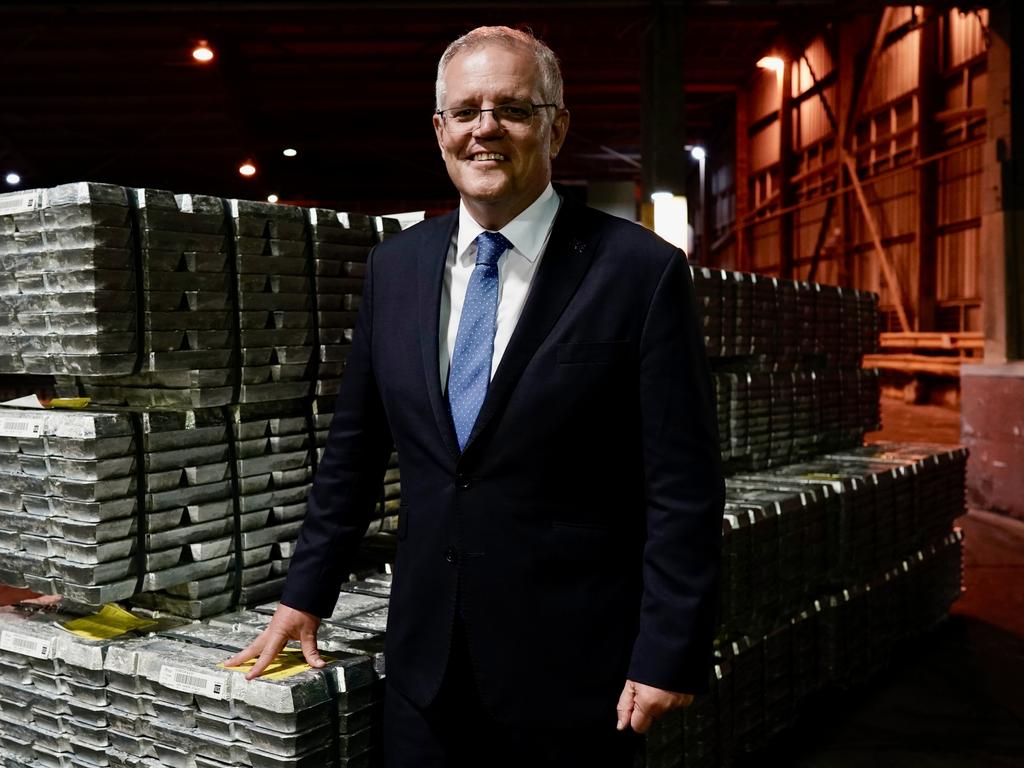Election 2022: We’re not talking about the crisis of labour and capital
Showstopping inflation has brought economic management back to the heart of the election campaign. Now it’s time to be honest.

Officials the world over are trying to find the least-worst policy mix of fighting resurgent inflation and avoiding a recession. It’s a narrow corridor. The International Monetary Fund warns the task is especially tricky for countries with highly indebted households and large fiscal deficits. Sound like any place you know?
“Moreover, with nominal wage growth still running behind price inflation in most countries, there is a risk that pent-up wage increases will materialise and add to overall price pressures,” the IMF said in its recent economic update. “In such a scenario, monetary policy would need to respond more aggressively than currently expected, further weighing on the outlook.”

The game has changed; inflation is here, broadly, deeply, and the RBA has been exposed as behind the play. The central bank’s credibility on “forward guidance”, telling the market what to expect and insisting it will be patient until the raw data hits it in the face, is as low as its 0.1 per cent cash rate. Naturally, with wages growth moving sideways for a decade due to stagnant productivity, further confirmation of the inflation surge embeds rising living costs at the centre of the election campaign. Yet neither Scott Morrison nor Anthony Albanese has a credible approach to deal with the underlying issues.
The Coalition, addicted to short-termism and sugar hits, put a $8.6bn relief package into the budget. More borrowed money stokes demand and raises inflation. How to achieve higher wages? Josh Frydenberg says change jobs in a tight labour market. One million workers have already done so. Even employers say that’s not a sustainable path to higher living standards.
Labor is cruising in the comfort zone of the medium term. Jim Chalmers claims Labor will train local workers for the high-skilled, good-paying jobs that are bound to come along given its support for innovation. Plus reducing childcare costs will boost workforce participation and Labor will back-in rises in the minimum wage.

On Wednesday at the National Press Club, when the Treasurer debates the man who wants his job, let’s hope they get out of the time machine of the Rudd-Gillard years and Covid-19 quagmire. They should have to explain how they will grow the economy faster in the next term, to deliver better pay outcomes and begin repairing a budget that has structural defects. Everything else is noise and talking-point filler.
Let’s get back to first principles. One of the essential things you learn in economics is there are four factors of production needed to generate goods and services: land, labour, capital and entrepreneurship. We have an abundance of the first and can always do with more of the last element. Right now, however, we have a national crisis involving the two middle factors. Before we can start the rescue, we need to talk openly about them – and that’s not happening in this minimalist, uptight campaign.
First, we need more workers. The jobless rate is about to fall below 4 per cent; there are 1.3 unemployed people for every job vacancy, the lowest value on record. The worker shortage, nearing extreme levels in construction, tourism, hospitality and agriculture, is due to the slump in migration.

In the decade before the pandemic, the working-age population was growing at 1.5 per cent a year. Growth in the civilian population aged above 15 years has collapsed, now running at around one-third of the long-term rate. Border closures and lockdowns to contain the spread of Covid-19 infections caused a net outflow of 100,000 migrants last financial year, including students, backpackers and skilled workers. It was the first loss of migrants since just after World War II and the lowest growth in population in over 100 years. Of those who did come as permanent settlers, a higher proportion than usual were in the family reunion stream.
The pause in the Big Australia Express certainly took the pressure off urban infrastructure, which had struggled to cope while population was growing by 1.5 per cent or almost 400,000 a year, with 60 per cent coming from net overseas migration.
The two-year handbrake on population has been eased, with the return of students from December and all vaccinated travellers in February. Treasury estimates around 100,000 more temporary migrants than expected a few months ago will arrive by the end of June. In any case, the nation’s population will be 600,000 smaller than pre-pandemic projections.
Given pronounced labour shortages, a broad range of business groups is calling for a migration catch-up, with an emphasis on skilled workers in the permanent program. During the pandemic, Morrison cut the permanent migration from 190,000 places a year to 160,000. In the budget, the Coalition announced the skill stream will rise to almost 110,000 for next year’s migration program or 70 per cent of all places.

While business welcomes the higher ratio of skilled migrants, it wants a much larger overall intake, faster visa processing for temporary workers, and pathways for those people to get permanent residency. The Australian Chamber of Commerce and Industry has called for 200,000 permanent skilled migrants in each of the next two years. The construction lobby, which delivers rail and road megaprojects, wants lower income taxes and access to Medicare for temporary workers as incentives to address an anticipated 105,000 unfilled jobs in the industry by mid next year.
The major parties are not flat-out rejecting there’s a skills crisis, but they’d prefer not to talk about migration, have a debate over numbers, sell higher migration to a public not keen on carrying settlement costs, and fight unions or the far right on “Aussie jobs for Aussie workers”.
So, we get migration policy on the sly, reform at the margins, and a muddle-through on population. Keep quiet and carry on.
Second, we need to resurrect business investment. Yes, there was a mining investment boom, with the global financial crisis a mere time-out in frenzied activity. State governments have lifted their game over the past decade, delivering transport projects that sat on the shelves of talk fast, do nothing premiers.
The Coalition balanced the budget before the pandemic, even with Labor’s legacy of unfunded social expansion. But its cruellest failure in government has been the decline in our capital stock, the main cause of our woeful productivity performance, drift in living standards, and real wage erosion. Workers have been toiling with second-best capital. The pandemic is no excuse.

There was an investment strike leading into the 2019 election. Perhaps businesses were scared to scale up investment when self-styled socialist terror Bill Shorten looked a shoo-in, given the disarray within the Coalition. Or maybe it was the lack of will and wit of a battered government that had failed to introduce an across-the-board cut to company tax, provide a believable framework for emissions abatement, cut regulation, revive enterprise bargaining, price infrastructure properly and provide world-competitive incentives for aspiring innovators.
Frydenberg has spent over $300bn in direct economic support for households and business. There have been accelerated tax breaks for investment, which increased spending on plant and equipment. And on tricked-out, twin-cab utes. That will get the kids to school in style, maybe even some quiet votes on May 21 for the tradies’ friend in high-vis. But it won’t lead to a more dynamic or productive economy.
Business investment as a share of the economy was close to 18 per cent when the Coalition came to office in 2013; the ratio has drifted down to 11 per cent, a plunge worse than the recession “we had to have” at the start of the 1990s and its asset-price bust. We’ve just come through an era of free money and good profits, so where’s the fresh capital? Isn’t the Coalition supposed to be the friend of business, which is meant to lead the recovery out of the pandemic?
Before last month’s budget, the Business Council put forward a policy wish list, focused on skilling workers, reviving migration and rebooting investment. All the other industry players were on the same page, with allowances for different memberships.
The BCA gave the Treasurer’s fourth budget a tick on living-cost relief and other housekeeping tweaks. But there was a big hole in the space where Big Capital would cheer on reforms to improve the “investment equation”. “Long-term business investment remains the missing link,” BCA chief executive Jennifer Westacott said forlornly on budget night. She pointed to a “severe business investment decline” in the budget’s outer years, and GDP growth slowing to an insipid 2.5 per cent.

“That is not the basis of sustained wages growth,” Westacott said. “We need to permanently make Australia a more attractive investment destination and a more competitive place to do business, that’s how we deliver sustained, higher wages. Both sides of politics agree we need to deliver a business-led recovery. To do this, we must drive investment to transform our economy and put Australians in the box seat.’’
More investment and skilled workers are the open secret to productivity growth and prosperity. Morrison and Albanese are closed shops; too stuck in the old ways to think creatively about modern capital and labour, let alone bold enough to lead a national conversation on how to fashion a new growth model.
Even when politicians try to be better, and some do, their opponents take cheap shots to score easy points. Frydenberg and Chalmers, just settling in for long hauls, must be more ambitious and honest about how to optimise these two precious elements to growth. When they go head-to-head, we’ll discover whether they are the brave leaders that can take us into new terrain, or big-boss careerists, stumbling about on the tired, low road, talking smack.








The showstopping March quarter inflation news has brought economic management back to the heart of the election campaign. Tuesday’s Reserve Bank board meeting could lead to immediate rises in home mortgage rates. It will take only a few turns of the cash-rate dial for monetary policy to bite into the wallets of leveraged-to-the-teeth families.